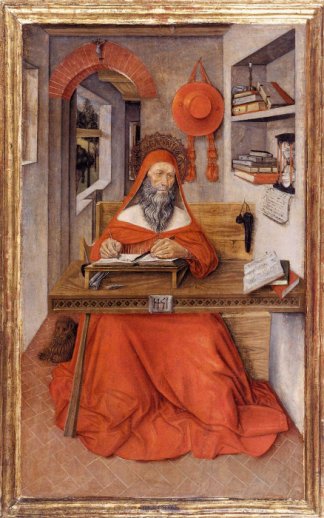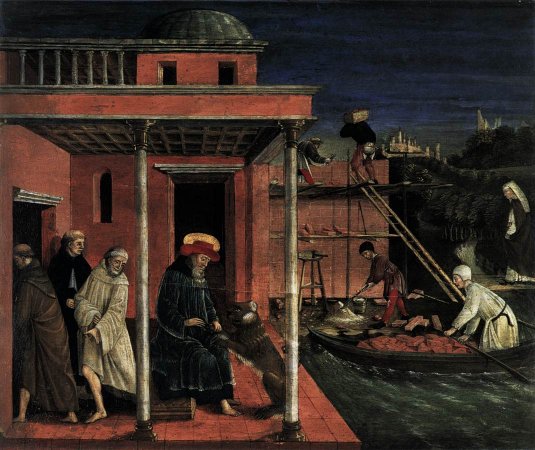|
Life with
the lion |
|
|
Few pictures of Jerome fail to include his most
familiar attribute, the lion. Unfortunately the story of the lion is not
just apocryphal; Jerome is actually the wrong saint. The legend was originally connected to
Saint Gerasimus, easily confused, I suppose, with Jerome (Hieronymus).
Gerasimus
also lived the life of an ascetic, but came a little later than Jerome. A
shame to spoil the story, but that's the way it is. Maybe it was not just
a case of mistaken identity though: the lion, with its fierceness, determination
and solitary life in the wilderness is an appropriate image for
Jerome. Indeed, Anna Jameson in Sacred and Legendary Art
suggests that the attribute of the lion had been applied to Jerome long
before the Gerasimus story came along, though she offers no specific evidence
for this. |
|
|
One day it happed that the ass was
in his field, and the lion was asleep. Merchants passed by with camels and
saw the ass alone, and they stole him and led him away. When the lion
awoke and could not find his fellow, he ran hither and thither looking for
him. When he saw that he could not be found he was broken-hearted and
dared not come in, but stayed at the gate of the church of the monastery;
he was ashamed that he came without the ass.
When the brothers saw that he was
late, and had come without the ass, they supposed that he had become
hungry and had eaten it. They would not feed him, and said
‘Go and eat the other part of the ass, and satisfy your
gluttony’. Because they doubted, and they wished to find out if he had
killed and eaten the ass, they went to the fields of the town to look. They
found nothing, and returned and told Jerome what had happened. He
commanded them to make the lion do the office of the ass. They cut down
bushes and boughs and laid them upon him, and he suffered it without
complaint.
On a day when he had done his work
he went out to the fields and began to run hither and thither, anxious to
know what had happened to his fellow. He saw from afar merchants that came
with laden camels, and the ass walking before them. When the lion saw the
ass, with a great roaring he ran on them so fiercely that all the
merchants fled. He frightened the camels so much by beating the earth with
his tail that he forced them to go straight to the monastery with all
their burdens. |
|
|
The
friendly lion appears in both study
and desert scenes. Durer's lion is particularly impressive. |
|
|
|
|
|
|
|
|
|
|
|
In the wonderful painting by Carpaccio in the Scuola di San Giorgio degli Schiavoni in Venice the lion has just arrived, much to the consternation of the monks. |
|
|
|
|
|
A number of paintings show the thorn being removed. In this intriguing version by an unknown Italian artist the monks are alarmed, but the building contractors are made of sterner stuff. |
|
|
|
|
| Sano di Pietro in his Jerome cycle covers all of the main events of Jerome's life, and this picture features all the best bits from the Golden Legend story: the removal of the thorn, the merchants helping themselves to the ass, and the rather angry lion taking it out on the camels. The cycle was painted for the Jesuit convent of San Girolamo (Jerome) in Siena: it is now in the Louvre. | |
|
|
|
|
The thorn in the lion's foot is a reminder of the Androcles myth, and perhaps this is the origin of the legend. That story is reminiscent of the suffering of Christian martyrs, and George Bernard Shaw in his version does turn Androcles into a Christian. |
|
|
|
|






